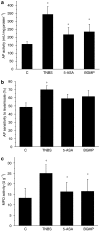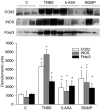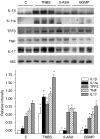Bovine glycomacropeptide ameliorates experimental rat ileitis by mechanisms involving downregulation of interleukin 17
- PMID: 18536735
- PMCID: PMC2439844
- DOI: 10.1038/bjp.2008.138
Bovine glycomacropeptide ameliorates experimental rat ileitis by mechanisms involving downregulation of interleukin 17
Abstract
Background and purpose: Bovine glycomacropeptide (BGMP) is an inexpensive, non-toxic milk peptide with anti-inflammatory effects in rat experimental colitis but its mechanism of action is unclear. It is also unknown whether BGMP can ameliorate inflammation in proximal regions of the intestine. Our aim was therefore two-fold: first, to determine the anti-inflammatory activity of BGMP in the ileum; second, to characterise its mechanism of action.
Experimental approach: We used a model of ileitis induced by trinitrobenzenesulphonic acid in rats. Rats were treated orally with BGMP and its efficacy compared with that of oral 5-aminosalicylic acid or vehicle, starting 2 days before ileitis induction.
Key results: BGMP pretreatment (500 mg kg(-1) day(-1)) resulted in marked reduction of inflammatory injury, as assessed by lower extension of necrosis and damage score, myeloperoxidase, alkaline phosphatase, inducible nitric oxide synthase, interleukin 1beta, tumour necrosis factor and interleukin 17. These effects were generally comparable to those of 5-aminosalicylic acid (200 mg kg(-1) day(-1)). Neither compound affected the production of interferon gamma, tumour necrosis factor and interleukin 2 by mesenteric lymph node cells isolated from animals with ileitis. The expression of Foxp3 was increased in ileitis and not reduced significantly by BGMP or aminosalicylate treatment.
Conclusions and implications: These results demonstrate that BGMP has anti-inflammatory activity in the ileum with similar efficacy to 5-aminosalicylic acid. The mechanism of action may involve Th17 and regulatory T cells and perhaps macrophages but probably not Th1 lymphocytes. Patients with Crohn's ileitis may benefit from treatment with BGMP.
Figures



Similar articles
-
Bovine glycomacropeptide has intestinal antiinflammatory effects in rats with dextran sulfate-induced colitis.J Nutr. 2010 Nov;140(11):2014-9. doi: 10.3945/jn.109.118448. Epub 2010 Sep 29. J Nutr. 2010. PMID: 20881082
-
Bovine glycomacropeptide is anti-inflammatory in rats with hapten-induced colitis.J Nutr. 2005 May;135(5):1164-70. doi: 10.1093/jn/135.5.1164. J Nutr. 2005. PMID: 15867298
-
A novel diamino-pyridine derivative (IS-741) attenuates rat ileitis induced by trinitrobenzene sulfonic acid.J Gastroenterol. 2003;38(5):451-9. doi: 10.1007/s00535-002-1081-8. J Gastroenterol. 2003. PMID: 12768387
-
Homeostatic (IL-7) and effector (IL-17) cytokines as distinct but complementary target for an optimal therapeutic strategy in inflammatory bowel disease.Curr Opin Gastroenterol. 2009 Jul;25(4):306-13. doi: 10.1097/MOG.0b013e32832bc627. Curr Opin Gastroenterol. 2009. PMID: 19448533 Review.
-
Anti-inflammatory mechanisms of bioactive milk proteins in the intestine of newborns.Int J Biochem Cell Biol. 2013 Aug;45(8):1730-47. doi: 10.1016/j.biocel.2013.04.028. Epub 2013 May 6. Int J Biochem Cell Biol. 2013. PMID: 23660296 Review.
Cited by
-
Bovine κ-Casein Fragment Induces Hypo-Responsive M2-Like Macrophage Phenotype.Nutrients. 2019 Jul 23;11(7):1688. doi: 10.3390/nu11071688. Nutrients. 2019. PMID: 31340476 Free PMC article.
-
Glycomacropeptide Ameliorates Indomethacin-Induced Enteropathy in Rats by Modifying Intestinal Inflammation and Oxidative Stress.Molecules. 2020 May 18;25(10):2351. doi: 10.3390/molecules25102351. Molecules. 2020. PMID: 32443501 Free PMC article.
-
Pretreatment with glycomacropeptide reduces allergen sensitization, alleviates immediate cutaneous hypersensitivity and protects from anaphylaxis.Clin Exp Immunol. 2012 Oct;170(1):18-27. doi: 10.1111/j.1365-2249.2012.04631.x. Clin Exp Immunol. 2012. PMID: 22943197 Free PMC article.
-
Glycomacropeptide Prevents Iron/Ascorbate-Induced Oxidative Stress, Inflammation and Insulin Sensitivity with an Impact on Lipoprotein Production in Intestinal Caco-2/15 Cells.Nutrients. 2020 Apr 22;12(4):1175. doi: 10.3390/nu12041175. Nutrients. 2020. PMID: 32331475 Free PMC article.
-
Flt3 ligand expands CD103⁺ dendritic cells and FoxP3⁺ T regulatory cells, and attenuates Crohn's-like murine ileitis.Gut. 2012 Aug;61(8):1154-62. doi: 10.1136/gutjnl-2011-300820. Epub 2011 Nov 7. Gut. 2012. PMID: 22068168 Free PMC article.
References
-
- Aimutis WR. Bioactive properties of milk proteins with particular focus on anticariogenesis. J Nutr. 2004;134:989S–995S. - PubMed
-
- Alexander F. Complications of ileal pouch anal anastomosis. Semin Pediatr Surg. 2007;16:200–204. - PubMed
-
- Bamias G, Martin C, Mishina M, Ross WG, Rivera-Nieves J, Marini M, et al. Proinflammatory effects of TH2 cytokines in a murine model of chronic small intestinal inflammation. Gastroenterology. 2005;128:654–666. - PubMed
-
- Bamias G, Okazawa A, Rivera-Nieves J, Arseneau KO, De La Rue SA, Pizarro TT, et al. Commensal bacteria exacerbate intestinal inflammation but are not essential for the development of murine ileitis. J Immunol. 2007;178:1809–1818. - PubMed
-
- Baumgart DC, Carding SR. Inflammatory bowel disease: cause and immunobiology. Lancet. 2007;369:1627–1640. - PubMed
Publication types
MeSH terms
Substances
LinkOut - more resources
Full Text Sources
Other Literature Sources
Research Materials

